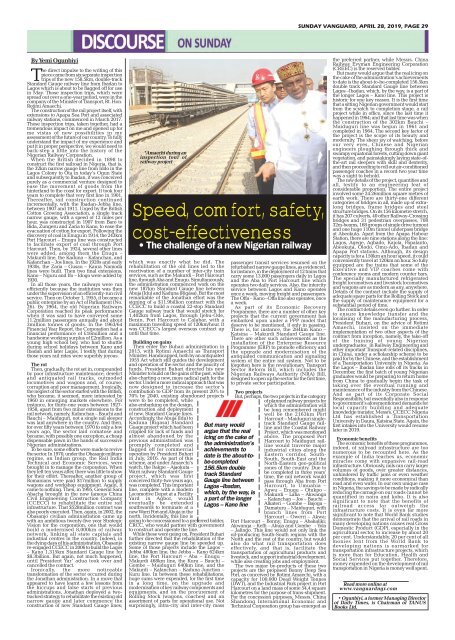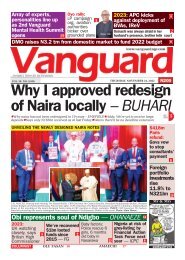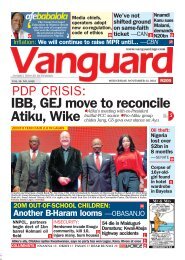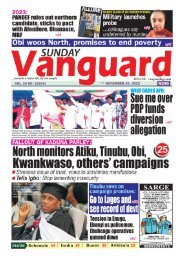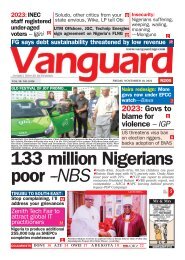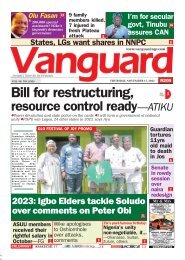You also want an ePaper? Increase the reach of your titles
YUMPU automatically turns print PDFs into web optimized ePapers that Google loves.
SUNDAY VANGUARD, APRIL 28, 2019, PAGE 29<br />
By Yemi Ogunbiyi<br />
The direct impulse to the writing of this<br />
piece came from six separate inspection<br />
trips of the new 158.5km, double-track<br />
St<strong>and</strong>ard Gauge railway line from Ibadan to<br />
La<strong>go</strong>s which is about to be flagged off for use<br />
in May. Those inspection trips, which were<br />
spread out over a one-year period, were in the<br />
company of the Minister of Transport, Rt. Hon.<br />
Rotimi Amaechi.<br />
The construction of the rail project itself, with<br />
extensions to Apapa Sea Port <strong>and</strong> associated<br />
railway stations, commenced in March 2017.<br />
Those inspection trips, taken together, had a<br />
tremendous impact on me <strong>and</strong> opened up for<br />
me vistas of new possibilities in my<br />
assessment of the future of our country. To fully<br />
underst<strong>and</strong> the impact of my experience <strong>and</strong><br />
put it in proper perspective, we would need to<br />
back-step a little into the history of the<br />
Nigerian Railway Corporation.<br />
When the British decided in 1898 to<br />
construct the first railroad in Nigeria, that is,<br />
the 32km narrow gauge line from Iddo in the<br />
La<strong>go</strong>s Colony to Ota in today’s Ogun State<br />
<strong>and</strong> subsequently to Ibadan, it was conceived<br />
purely as a commercial venture designed to<br />
ease the movement of <strong>go</strong>ods from the<br />
hinterl<strong>and</strong> to the coast for export. It took four<br />
years to complete that very first line in 1901.<br />
Thereafter, rail construction continued<br />
incrementally, with the Ibadan-Jebba line,<br />
between 1907 <strong>and</strong> 1911. Urged by the British<br />
Cotton Growing Association, a single track<br />
narrow gauge, with a speed of 12 miles per<br />
hour, was constructed in 1907 from Baro to<br />
Bida, Zungeru <strong>and</strong> Zaria to Kano, to ease the<br />
evacuation of cotton for export. Following the<br />
discovery of coal in Enugu in 1914, the 243km<br />
Port Harcourt – Enugu line was constructed<br />
to facilitate export of coal through Port<br />
Harcourt. Then, by 1924, several other lines<br />
were added, among them the Enugu –<br />
Makurdi line, the Kaduna – Kafanchan, <strong>and</strong><br />
Kafanchan – Jos lines. In the 1920s <strong>and</strong> early<br />
1930s, the Zaria – Gusau – Kaura Namoda<br />
lines were built. Then two final extensions,<br />
Kano – Nguru <strong>and</strong> Ifo – Ido<strong>go</strong> were added by<br />
1930.<br />
In all those years, the railways were run<br />
efficiently because the institution was then<br />
under the supervision of an efficiently-run civil<br />
service. Then on October 1, 1955, it became a<br />
public enterprise by an Act of Parliament (<strong>No</strong>.<br />
26). By 1964, the old Nigerian Railways<br />
Corporation reached its peak performance<br />
when it was said to have conveyed some<br />
11.2million passengers annually <strong>and</strong> about<br />
3million tonnes of <strong>go</strong>ods. In the 1963/64<br />
Financial Year Report, the Corporation had a<br />
financial performance of £16million <strong>and</strong> a<br />
h<strong>and</strong>some working surplus of £2million. As a<br />
young high school boy, who had to shuttle<br />
during school holidays between Kano <strong>and</strong><br />
Ibadan <strong>and</strong> later La<strong>go</strong>s, I testify that during<br />
those years rail rides were superbly joyous.<br />
The rot<br />
Then, gradually, the rot set in, compounded<br />
by poor infrastructure maintenance, derelict<br />
<strong>and</strong> antiquated rail tracks, outmoded<br />
locomotives <strong>and</strong> wa<strong>go</strong>ns <strong>and</strong>, of course,<br />
corruption <strong>and</strong> poor management. Ironically,<br />
the neglect of the sector started with the British,<br />
who became, it seemed, more interested by<br />
1960 in emerging markets elsewhere. For<br />
instance, for thirty-one years between 1927-<br />
1958, apart from two minor extensions to the<br />
rail network, namely, Kafanchan – Bauchi <strong>and</strong><br />
Bauchi – Maiduguri, not a single rail sleeper<br />
was laid anywhere in the country. And then,<br />
for over fifty years between 1970 to only a few<br />
years a<strong>go</strong>, the sector laid comatose <strong>and</strong><br />
became, with possibly one exception, a cheap<br />
dispensable pawn in the h<strong>and</strong>s of successive<br />
Nigerian administrations.<br />
To be sure, some efforts were made to revive<br />
the sector. In 1970, under the Obasanjo military<br />
regime, an Indian group, the Rail India<br />
Technical <strong>and</strong> Economic Services, were<br />
brought in to manage the corporation. When<br />
they left ten years after, there was little to show<br />
for their effort. Thereafter, another group of<br />
Romanians were paid $17million to supply<br />
wa<strong>go</strong>ns <strong>and</strong> workshop equipment. Again, it<br />
came to nothing. Then, in 1995, General Sani<br />
Abacha brought in the now famous China<br />
Civil Engineering Construction Company<br />
(CCECC) to rehabilitate the entire rail<br />
infrastructure. That $528million contract was<br />
also poorly executed. Then, again, in 2002, the<br />
Obasanjo civilian administration came up<br />
with an ambitious twenty-five year Strategic<br />
Vision for the corporation, one that would<br />
build a modernised 8,000km of railway<br />
network, linking all state capitals <strong>and</strong><br />
industrial centres in the country. Indeed, in<br />
the dying days of his administration, Obasanjo<br />
re-engaged CCECC in 2006 to build the La<strong>go</strong>s<br />
– Kano 1,315km St<strong>and</strong>ard Gauge line for<br />
$8.3billion. But again, not much happened,<br />
until President Yar’ adua took over <strong>and</strong><br />
cancelled the contract.<br />
Ironically, the more noticeable<br />
transformation of the sector occurred during<br />
the Jonathan administration. In a move that<br />
appeared to have learnt a few lessons from<br />
the hiccups <strong>and</strong> false starts of previous<br />
administrations, Jonathan deployed a twotracked<br />
strategy to rehabilitate the existing old<br />
narrow gauge <strong>and</strong> later commence the<br />
construction of new St<strong>and</strong>ard Gauge lines;<br />
*Amaechi during an<br />
inspection tour of<br />
railway project<br />
Speed, comfort, safety,<br />
cost-effectiveness<br />
• The challenge of a new Nigerian railway<br />
which was exactly what he did. The<br />
rehabilitation of the old lines led to the<br />
reactivation of a number of inter-city train<br />
services, such as the Makurdi – Port Harcourt<br />
line, through Aba <strong>and</strong> Enugu. Simultaneously,<br />
the administration commenced work on the<br />
new 187km St<strong>and</strong>ard Gauge line between<br />
Abuja (Idu) <strong>and</strong> Kaduna (Rigasa). But the most<br />
remarkable of the Jonathan effort was the<br />
signing of a $11.9billion contract with the<br />
CCECC to build a coastal 22-stop St<strong>and</strong>ard<br />
Gauge railway track that would stretch for<br />
1,402km from La<strong>go</strong>s, through Ijebu-Ode,<br />
Benin, Port Harcourt to Calabar, with a<br />
maximum travelling speed of 120km/hour. It<br />
was CCECC’s largest overseas contract up<br />
until that time.<br />
Building on gains<br />
Then enter the Buhari administration in<br />
2015, with Rotimi Amaechi as Transport<br />
Minister. H<strong>and</strong>icapped, both by an antiquated<br />
1955 Act which still guides the development<br />
<strong>and</strong> operation of the sector <strong>and</strong> the paucity of<br />
funds, President Buhari directed his new<br />
Minister to build on the gains of the past, while<br />
also charting a new, more radical path for the<br />
sector. Under a more radical approach that was<br />
now designed to increase the sector’s<br />
contribution to GDP from its present 20% to<br />
70% by 2040, existing ab<strong>and</strong>oned projects<br />
were to be completed, while<br />
also embarking on the design,<br />
construction <strong>and</strong> deployment<br />
of new, St<strong>and</strong>ard Gauge lines.<br />
Accordingly, the Abuja (Idu) to<br />
Kaduna (Rigasa) St<strong>and</strong>ard<br />
Guage project which had been<br />
crippled for lack of funds <strong>and</strong><br />
almost ab<strong>and</strong>oned by the<br />
previous administration was<br />
promptly completed <strong>and</strong><br />
flagged off for commercial<br />
operation by President Buhari<br />
in July, 2016. As part of this<br />
scheme, <strong>and</strong> under Amaechi’s<br />
watch, the Itakpe – Ajaokuta –<br />
Warri railway St<strong>and</strong>ard Gauge<br />
project, which was first<br />
conceived thirty-two years a<strong>go</strong>,<br />
was completed. This important<br />
line, complete with a modern<br />
Locomotive Depot at a Facility<br />
Yard in Agbor, would<br />
eventually be extended<br />
southwards to terminate at a<br />
new Warri Port <strong>and</strong> Abuja in the<br />
north. Incidentally, this line is<br />
<strong>go</strong>ing to be concessioned to a preferred bidder,<br />
CRCC, who would partner with <strong>go</strong>vernment<br />
to construct <strong>and</strong> operate the line.<br />
While these were <strong>go</strong>ing on, President Buhari<br />
further directed that the rehabilitation of the<br />
existing narrow gauge line be speeded up.<br />
Some of those projects include the La<strong>go</strong>s –<br />
Jebba 480km line, the Jebba – Kano 624km<br />
line, the Port Harcourt – Aba – Enugu –<br />
Makurdi 468km line, the Kuru – Bauchi –<br />
Gombe – Maiduguri 640km line, <strong>and</strong> the<br />
Makurdi – Kafanchan – Kaduna Junction –<br />
Kuru line. In between these rehabilitations,<br />
huge sums were expended, for the first time<br />
in a long time, on the upgrade <strong>and</strong><br />
modernisation of key railway components <strong>and</strong><br />
equipments, <strong>and</strong> on the procurement of<br />
Rolling Stock (wa<strong>go</strong>ns, coaches) <strong>and</strong> an<br />
assortment of parts for operational use. <strong>No</strong>t<br />
surprisingly, intra-city <strong>and</strong> inter-city mass<br />
But many would<br />
argue that the real<br />
icing on the cake of<br />
the administration’s<br />
achievements to<br />
date is the about-tobe-completed<br />
156.5km double<br />
track St<strong>and</strong>ard<br />
Gauge line between<br />
La<strong>go</strong>s –Ibadan,<br />
which, by the way, is<br />
a part of the longer<br />
La<strong>go</strong>s – Kano line<br />
passenger transit services resumed on the<br />
refurbished narrow gauge lines, as evidenced,<br />
for instance, in the deployment of 12 trains that<br />
carry some 13,000 passengers daily in La<strong>go</strong>s<br />
<strong>and</strong> the Aba to Port Harcourt line which<br />
operates two daily services. Also, the intercity<br />
service between La<strong>go</strong>s <strong>and</strong> Kano operates<br />
once a week, moving freight <strong>and</strong> passengers.<br />
The Offa – Kano –Offa line also operates, once<br />
a week.<br />
As part of its Economic Recovery<br />
Programme, there are a number of other key<br />
projects that the current <strong>go</strong>vernment has<br />
embarked upon under a PPP model that<br />
deserve to be mentioned, if only in passing.<br />
There is, for instance, the 284km Kano –<br />
Katsina – Makurdi St<strong>and</strong>ard Gauge line.<br />
There are other such achievements as the<br />
installation of the Enterprise Resource<br />
Programme (ERP) to promote efficiency <strong>and</strong><br />
the upgrade <strong>and</strong> modernisation of the<br />
antiquated communication <strong>and</strong> signaling<br />
system of the entire rail system. <strong>No</strong>t to be<br />
for<strong>go</strong>tten here is the revolutionary Transport<br />
Sector Reform Bill, which includes the<br />
Nigerian Railways Authority (NRA) Bill,<br />
designed to open up the sector for the first time,<br />
to private sector participation.<br />
Two projects<br />
But, perhaps, the two projects in the cate<strong>go</strong>ry<br />
of planned railway projects for<br />
which the administration will<br />
be long remembered might<br />
well be the 2163km Port<br />
Harcourt – Maiduguri singletrack<br />
St<strong>and</strong>ard Gauge railline<br />
<strong>and</strong> the Coastal Railway<br />
Project, which was mentioned<br />
above. The proposed Port<br />
Harcourt to Maiduguri railline<br />
would traverse major<br />
industrial cities along the<br />
Eastern corridor, South-<br />
South, South-East <strong>and</strong> the<br />
<strong>No</strong>rth-Eastern geo-political<br />
zones of the country. Due to<br />
be completed in three years’<br />
time, the rail network would<br />
pass through Aba from Port<br />
Harcourt, to Umuahia –<br />
Agwu – Enugu – Otukpo –<br />
Makurdi – Lafia – Akwanga<br />
– Kafanchan – Jos – Bauchi –<br />
Alkateri – Gombe – Bajoga –<br />
Damaturu – Maiduguri, with<br />
branch lines from Port<br />
Harcourt – Owerri – Akwa;<br />
Port Harcourt – Bonny; Enugu – Abakaliki;<br />
Akwanga – Keffi – Abuja <strong>and</strong> Gombe - Yola<br />
– Jalin<strong>go</strong>. This line would not only link the<br />
oil-producing South-South regions with the<br />
<strong>No</strong>rth <strong>and</strong> the rest of the country, but would<br />
also do what rail transportation does<br />
effectively, <strong>and</strong> that is, facilitate the<br />
transportation of agricultural products <strong>and</strong><br />
livestock, <strong>and</strong> support industrial development,<br />
while also creating jobs <strong>and</strong> employment.<br />
The two major by-products of these two<br />
projects are the proposed Bonny Deep Sea<br />
Port, as conceived by Rotimi Amaechi, with a<br />
capacity for 100,000 Dead Weight Tonnes<br />
(DWT), <strong>and</strong> the Industrial Park project in Port<br />
Harcourt on a l<strong>and</strong> mass of some 54.4 square<br />
kilometres for the purpose of trans-shipment.<br />
For the concession purposes, Messrs. China<br />
Sh<strong>and</strong>ong International Economic <strong>and</strong><br />
Technical Corporation group has emerged as<br />
the preferred partner, while Messrs. China<br />
Railway Evyman Engineering Corporation<br />
(CREEC) is the reserved bidder.<br />
But many would argue that the real icing on<br />
the cake of the administration’s achievements<br />
to date is the about-to-be-completed 156.5km<br />
double track St<strong>and</strong>ard Gauge line between<br />
La<strong>go</strong>s –Ibadan, which, by the way, is a part of<br />
the longer La<strong>go</strong>s – Kano line. This project is<br />
historic for one key reason. It is the first time<br />
that a sitting Nigerian <strong>go</strong>vernment would start<br />
from the scratch to completion stage, a rail<br />
project while in office, since the last time it<br />
happened in 1964; <strong>and</strong> that last time was when<br />
the construction of the 302km Bauchi –<br />
Maiduguri line was begun in 1961 <strong>and</strong><br />
completed in 1964. The second key factor of<br />
the project is the scope of its beauty <strong>and</strong><br />
modernity. The sheer joy of watching, before<br />
our very eyes, Chinese <strong>and</strong> Nigerian<br />
engineers ploughing through thick <strong>and</strong><br />
swampy equatorial forests, cutting down giant<br />
vegetation, <strong>and</strong> painstakingly laying state-ofthe-art<br />
rail sleepers with skill <strong>and</strong> dexterity,<br />
<strong>and</strong> then proceeding to roll out air-conditioned<br />
passenger coaches in a record two year time<br />
was a sight to behold.<br />
The raw details of the project, quantities <strong>and</strong><br />
all, testify to an engineering feat of<br />
considerable proportion. The entire project<br />
involved some 24.26million square metres of<br />
earth work. There are thirty-one different<br />
cate<strong>go</strong>ries of bridges in all, made up of extralong<br />
bridges, frame bridges <strong>and</strong> steel<br />
structure bridges. On its 156 kilometre stretch,<br />
it has 207 culverts, 40 other Railway-Crossing<br />
bridges <strong>and</strong> 31 pedestrian overpasses, 708<br />
32m-beams, 168 groups of single drive turnout<br />
<strong>and</strong> one huge 110m tunnel underpass bridge<br />
at Abeokuta. Apart from the Apapa Habour<br />
Station, there are nine stations along the line:<br />
La<strong>go</strong>s, Agege, Agbado, Kajola, Papalanto,<br />
Abeokuta, Olodo, Omu-Ado, Ibadan <strong>and</strong><br />
Apapa Port stations. Although, its design<br />
capacity is for a 150km an hour speed, it could<br />
conveniently travel at 120km an hour. So fully<br />
equipped are the trains that some of the<br />
Executive <strong>and</strong> VIP coaches come with<br />
conference rooms <strong>and</strong> modern counter bars.<br />
The specially manufactured refrigerated<br />
freight locomotives <strong>and</strong> livestock locomotives<br />
<strong>and</strong> wa<strong>go</strong>ns are as modern as any, anywhere.<br />
Details of the contract include the supply of<br />
adequate spare parts for the Rolling Stock <strong>and</strong><br />
the supply of maintenance equipment for a<br />
substantial period of time.<br />
The contract details even <strong>go</strong> further. In order<br />
to ensure knowledge transfer <strong>and</strong> the<br />
localising of the manufacturing process,<br />
President Buhari, on the advice of Rotimi<br />
Amaechi, insisted on the immediate<br />
implementation of two other aspects of the<br />
contract from inception, namely, the take-off<br />
of the training of young Nigerian<br />
undergraduates in Railway Engineering <strong>and</strong><br />
other important Transport-related disciplines,<br />
in China, under a scholarship scheme to be<br />
paid for by the Chinese, <strong>and</strong> the establishment<br />
of a Transportation University in Nigeria. As<br />
the La<strong>go</strong>s – Ibadan line rolls off its tracks in<br />
December, the first batch of young Nigerian<br />
graduates would be preparing to return home<br />
from China to gradually begin the task of<br />
taking over the eventual running <strong>and</strong><br />
maintenance of the industry from the Chinese.<br />
And as part of its Corporate Social<br />
Responsibility, but essentially also in response<br />
to <strong>go</strong>vernment’s aforementioned dem<strong>and</strong>s for<br />
local capacity building <strong>and</strong> adequate<br />
knowledge transfer, Messrs. CCECC Nigeria<br />
Ltd has established a Transportation<br />
University in Daura, Katsina State. Again, the<br />
first intakes into the University would resume<br />
later in 2019.<br />
Economic benefits<br />
The economic benefits of these programmes,<br />
indeed, of railroad infrastructure are too<br />
numerous to be recounted here. As the<br />
example of India teaches us, economic<br />
miracles come with expansive rail-road<br />
infrastructure. Obviously, rails can carry larger<br />
volumes of <strong>go</strong>ods, over greater distances,<br />
unhindered by traffic jams or even weather<br />
conditions, making it more economical than<br />
road <strong>and</strong> even water. In our own unique case<br />
in Nigeria, the savings to be made by radically<br />
reducing the carnage on our roads cannot be<br />
quantified in naira <strong>and</strong> kobo. It is also<br />
significant to note that the benefits of<br />
railroad access far outweigh the<br />
infrastructure costs. It is even far more<br />
significant to note that World Bank studies<br />
demonstrate that the arrival of rail roads in<br />
many developing nations causes real Gross<br />
Domestic Product (GDP), especially in the<br />
agricultural sector, to increase by about 20<br />
per cent. Underst<strong>and</strong>ably, 20 per cent of all<br />
monies lent from the World Bank to<br />
developing nations is earmarked for<br />
transportation infrastructure projects, which<br />
is more than for Education, Health <strong>and</strong><br />
Social Services put together. Therefore,<br />
money expended on the development of rail<br />
transportation in Nigeria is money well spent.<br />
Read more online at<br />
www.vanguardngr.com<br />
• Ogunbiyi, a former Managing Director<br />
of Daily Times, is Chairman of TANUS<br />
Books Ltd.


